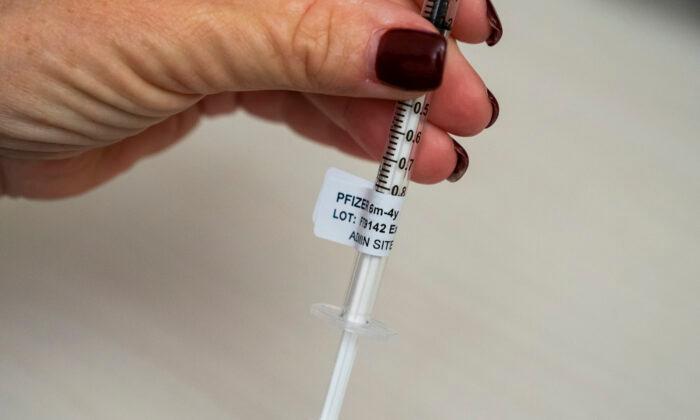The data for Pfizer’s booster was based on just 8 mice, Pfizer scientists told the U.S. Food and Drug Administration’s (FDA) vaccine advisory panel in June. The data for Moderna’s booster was based on 16 to 20 mice, some of which received the original booster, according to a presentation slated to be delivered to the U.S. Centers for Disease Control and Prevention’s (CDC) advisory panel on Sept. 1.
The mice data show “substantial increases against all Omicron sublineages including BA.4/5 as well as the reference strain with the BA.4/5- modified vaccines,” Kena Swanson, Pfizer’s vice president for vaccine research and development, told the FDA panel.
BA.4 and BA.5 are both subvariants of the Omicron variant of the virus that causes COVID-19.
Both Moderna and Pfizer developed boosters containing parts of the original COVID-19 virus and the BA.1 subvariant, but the FDA after the June meeting asked the vaccine makers to switch out the BA.1 component for a component targeting BA.4 and BA.5, the latter of which is the dominant strain in the United States.
The FDA declined to require human trial data for authorization, and granted authorization for both updated boosters on Aug. 31.
The mice data “demonstrate that these vaccines successfully evoke an immune response in the same way previous versions of the vaccine have,” Dr. Peter Marks, a top FDA vaccine official, told reporters on a call.
CDC Director Dr. Rochelle Walensky also signaled support for the path.
Unprecedented
Dr. Monica Gandhi, a professor of medicine at University of California, San Francisco, said that she thinks the updated booster “has the potential to increase antibodies in humans to the circulating subvariant (mainly BA.5 at this point), but to be fair, we need to note that we only have data in mice of increased antibodies at this point.”“We do not have human data on this new booster, either antibody data or clinical data. However, there is biological plausibility that these updated boosters will curb cases by increasing antibodies as we enter the winter,” Gandhi told The Epoch Times in an email.
The FDA is advising all Americans 12 and older to get the updated booster just two months after their latest shot.
“It’s still the same vaccine, just with a small tweak. The same strategy is used every year to adjust the composition of the standard flu vaccines. I’d draw an analogy to getting a new paint job on your car—that would not trigger the need for a full-service check into all the safety features. However, I think many members of the public may be concerned—particularly ones who have listened to the lies from anti-vaxxers,” he added, using a pejorative for people concerned about vaccine side effects and waning effectiveness.
Trial data is available for the boosters that contain BA.1. That data showed the boosters worked better than the boosters that were being administered, which targeted just the original virus variant.
That variant was displaced early in the pandemic. A series of variants have since emerged. Omicron became dominant in the United States in late 2021. The strain and its subvariants have proven better able to evade the protection bestowed by vaccines, triggering the clearance and recommendation of boosters and, now, the authorization of the updated boosters.
The CDC convened its advisory panel on Thursday to ask whether it should recommend people get an updated booster, or merely say people may get an updated booster.





